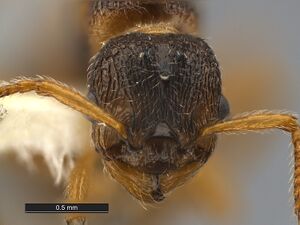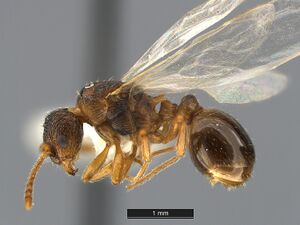Myrmica quebecensis
| Myrmica quebecensis | |
|---|---|

| |
| Conservation status | |
| Scientific classification | |
| Kingdom: | Animalia |
| Phylum: | Arthropoda |
| Class: | Insecta |
| Order: | Hymenoptera |
| Family: | Formicidae |
| Subfamily: | Myrmicinae |
| Tribe: | Myrmicini |
| Genus: | Myrmica |
| Species: | M. quebecensis |
| Binomial name | |
| Myrmica quebecensis Francoeur, 1981 | |
A social parasite of Myrmica alaskensis.
| At a Glance | • Workerless Inquiline |
Identification
One of two known parasites of Myrmica alaskensis. Both parasites are only known from queens and males. Francoeur (1984) provided a couplet for distinguishing M. quebecensis from the other parasite, Myrmica lampra.
Key to species of the lampra group
1. Ocular index < 26 (eye diameter x 100/head width). Propodeal spines well developed, as long as or longer than one-half the distance which separates their bases. Body bicolored, reddish or yellowish brown. Female habitus . . . . . 2
Ocular index >30. Propodeal spines reduced, as long as or shorter than one-third the distance which separates their bases. Concolorous body, dark to blackish brown. Male habitus . . . . . 3
2. Petiolar sternum with a median keel protruded anteriorly into an angular lobe. Anterior margin of clypeus angulo-convex. Eyes with long reclinate hairs. Fine striae on dorsum of head . . . . . lampra
Petiolar sternum with a strong vertical lamella. Anterior margin of clypeus weakly convex. Eyes only with short straight hairs. Coarse striae on dorsum of head . . . . . quebecensis
3. Petiolar sternum with a median keel feebly protruding anteriorly like a spine. Scape equal to the first 7.5 meres of the funiculum, scape index = 84 (scape length x 100/head width) . . . . . lampra
Petiolar sternum with an elongated lamella, directed downward and forward. Scape equal to the first 5 meres of the funiculum. scape index < 62 . . . . . . quebecensis
Keys including this Species
Distribution
Francoeur and Loiselle (1984) - M. quebecensis occupies most of the area known as Cote-Nord, which is the north shore of the St. Lawrence Estuary in Saguenay. Its presence farther south in the Parc des Grands-Jardins is a novelty for Quebec, while the discovery of a female from Manitoba is a considerable extension of area to the west.
It is not yet known to what northern latitude the territory of this species extends. As it was found exclusively in the typical or more or less regressed habitats of the Black Spruce in Cladonia (Beique and Francoeur 1966, 1968), we can expect that its territory coincides mainly with that of this transcontinental climatic domain and its host. However, it has not been reported in the treeline areas of northern Quebec where the host species continues (Francoeur 1983). The climatic conditions prevailing in the northernmost zone of this climatic domain could limit its expansion (Hare 1950, Payette 1983). It is an additional species to add to the myrmecofauna of boreal coniferous forest in North America.
Latitudinal Distribution Pattern
Latitudinal Range: 53.63° to 45.62°.
| North Temperate |
North Subtropical |
Tropical | South Subtropical |
South Temperate |
- Source: AntMaps
Distribution based on Regional Taxon Lists
Nearctic Region: Canada (type locality).
Distribution based on AntMaps
Distribution based on AntWeb specimens
Check data from AntWeb
Countries Occupied
| Number of countries occupied by this species based on AntWiki Regional Taxon Lists. In general, fewer countries occupied indicates a narrower range, while more countries indicates a more widespread species. |

|
Estimated Abundance
| Relative abundance based on number of AntMaps records per species (this species within the purple bar). Fewer records (to the left) indicates a less abundant/encountered species while more records (to the right) indicates more abundant/encountered species. |

|
Biology
Francoeur and Loiselle (1984) - Its status as a parasite is no longer in doubt. On three occasions during the first week of June 1983, we collected a wingless queen of M. quebecensis accompanied by M. alaskensis workers and large larvae. This set was always located in a peripheral zone of the nest of the host species of which the queen (or the queens, because these colonies are generally polygynous), if present, has not been spotted. As the nest is diffuse and spread in the soil and/or dead wood, it is difficult to draw conclusions on this point in the circumstances. The flourishing state of the host colonies suggests the presence of queens. In the lab, sub-colonies with the parasite produced only males and females of M. quebecensis. The proportion of the sexes remained unfavorable to the males, only 7 out of 45 individuals. The size of the larvae at the time of harvest indicates that the parasite has a normal cycle of development: these larvae came from eggs laid the previous year, experienced a winter diapause and resumed their development towards the end of the year. Myrmica alaskensis normally looked after the brood, licking and moving them around. The imagos appeared during the first 2 weeks of July. Then the queens of M. quebecensis began to lay eggs. This fact would indicate the existence of a single annual laying period instead of two, which would be consistent with the absence of workers. We have observed frequent attempts by males to mate within the artificial nests, without the individuals of both sexes seeking to leave these boundaries. It may be thought that mating can easily take place inside the nest or on the surface, without the need for a nuptial flight. These observations fit well with those of Elmes (1983) on the European parasite Myrmica hirsuta.
During an internship at our laboratory, Dr. Alfred Buschinger (Darmstadt, FRG) tried unsuccessfully 6 times to introduce a M. quebecensis female into a normal colony (with queen, worker and brood) of M. alaskensis that was kept in an artificial nest. The parasite queens were killed within 24 hours. We tried once to introduce the parasite into a group of workers without a queen, but without success. The dissection of 2 females, from the same colony as the 6 preceding ones, revealed the presence of spermatozoa in the spermatheque, and the absence of yellow bodies. They were young females of the year who had not yet laid eggs. All the queens of M. quebecensis were found in flourishing colonies, characterized by the presence of large, dark colored workers. The queens were different enough from the workers to be readily distinguished from the host species when they were in the nest.
Castes
   
| |
| . | Owned by Museum of Comparative Zoology. |
Images from AntWeb

| |
| Topotype of Myrmica quebecensis. Queen (alate/dealate). Specimen code casent0103458. Photographer April Nobile, uploaded by California Academy of Sciences. | Owned by LACM, Los Angeles, CA, USA. |
Nomenclature
The following information is derived from Barry Bolton's Online Catalogue of the Ants of the World.
- quebecensis. Myrmica quebecensis Francoeur, 1981: 756, figs. 5, 6 (q.) CANADA. Francoeur & Loiselle, 1984: 4 (m.).
Unless otherwise noted the text for the remainder of this section is reported from the publication that includes the original description.
Description
Type Material
Holotype: a wingless female found by Claude Villeneuve in a colony of M. alaskensis, Lac Lessard, Earl of Chicoutimi, 6-IX-1975, deposited in the author's collection, no. 04974. Paratype: a lone wingless female, captured by H. Eidman, at Matamek River, County of Saguenay, 29-VIII-1931, belonging to the Museum of Natural History of Basel, Switzerland. Reference origin:Chicoutimi and Saguenay, Quebec.
Etymology
Named for the Canadian province where the species was discovered.
References
- Francoeur, A. 1981c. Le groupe néarctique Myrmica lampra (Formicidae, Hymenoptera). The Canadian Entomologist. 113:755-759. (page 756, figs. 5,6; queen described)
- Francoeur, A.; Loiselle, R. 1984. Description du mâle et notice sur la biologie de Myrmica quebecensis Francoeur (Formicidae, Hymenoptera). Revue D'Entomologie Du Quebec. 29:3-11. (page 4, male described)
- Jansen, G., Savolainen, R., Vepsäläinen, K. 2010. Phylogeny, divergence-time estimation, biogeography and social parasite–host relationships of the Holarctic ant genus Myrmica (Hymenoptera: Formicidae). Molecular Phylogenetics and Evolution 561, 294–304 (doi:10.1016/j.ympev.2010.01.029).
References based on Global Ant Biodiversity Informatics
- Francoeur A. 2011. Extension de l'aire connue de la fourmi Myrmica quebecensis (Formicidae, Hymenoptera). Le Naturaliste Canadien 135(2): 24-25.
- Francoeur A., and R. Loiselle. 1984. Description du mâle et notice sur la biologie de Myrmica quebecensis Francoeur (Formicidae, Hymenoptera). Rev. Entomol. Qué. 29: 3-11.
- Glasier J. R. N., S. E. Nielsen, J. Acorn, and J. Pinzon. 2019. Boreal sand hills are areas of high diversity for Boreal ants (Hymenoptera: Formicidae). Diversity 11, 22; doi:10.3390/d11020022.
- Pages using DynamicPageList3 parser function
- IUCN Red List vulnerable species
- Ant Associate
- Host of Myrmica alaskensis
- Workerless Inquiline
- North temperate
- Species
- Extant species
- Formicidae
- Myrmicinae
- Myrmicini
- Myrmica
- Myrmica quebecensis
- Myrmicinae species
- Myrmicini species
- Myrmica species
- Need Overview
- Need Body Text
- IUCN Red List
- Ssr






